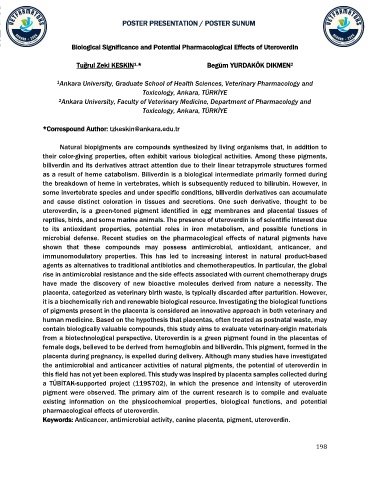Page 201 - congress
P. 201
POSTER PRESENTATION / POSTER SUNUM
Biological Significance and Potential Pharmacological Effects of Uteroverdin
,
Tuğrul Zeki KESKIN¹ * Begüm YURDAKÖK DIKMEN 2
1 Ankara University, Graduate School of Health Sciences, Veterinary Pharmacology and
Toxicology, Ankara, TÜRKİYE
2 Ankara University, Faculty of Veterinary Medicine, Department of Pharmacology and
Toxicology, Ankara, TÜRKİYE
*Correspound Author: tzkeskin@ankara.edu.tr
Natural biopigments are compounds synthesized by living organisms that, in addition to
their color-giving properties, often exhibit various biological activities. Among these pigments,
biliverdin and its derivatives attract attention due to their linear tetrapyrrole structures formed
as a result of heme catabolism. Biliverdin is a biological intermediate primarily formed during
the breakdown of heme in vertebrates, which is subsequently reduced to bilirubin. However, in
some invertebrate species and under specific conditions, biliverdin derivatives can accumulate
and cause distinct coloration in tissues and secretions. One such derivative, thought to be
uteroverdin, is a green-toned pigment identified in egg membranes and placental tissues of
reptiles, birds, and some marine animals. The presence of uteroverdin is of scientific interest due
to its antioxidant properties, potential roles in iron metabolism, and possible functions in
microbial defense. Recent studies on the pharmacological effects of natural pigments have
shown that these compounds may possess antimicrobial, antioxidant, anticancer, and
immunomodulatory properties. This has led to increasing interest in natural product-based
agents as alternatives to traditional antibiotics and chemotherapeutics. In particular, the global
rise in antimicrobial resistance and the side effects associated with current chemotherapy drugs
have made the discovery of new bioactive molecules derived from nature a necessity. The
placenta, categorized as veterinary birth waste, is typically discarded after parturition. However,
it is a biochemically rich and renewable biological resource. Investigating the biological functions
of pigments present in the placenta is considered an innovative approach in both veterinary and
human medicine. Based on the hypothesis that placentas, often treated as postnatal waste, may
contain biologically valuable compounds, this study aims to evaluate veterinary-origin materials
from a biotechnological perspective. Uteroverdin is a green pigment found in the placentas of
female dogs, believed to be derived from hemoglobin and biliverdin. This pigment, formed in the
placenta during pregnancy, is expelled during delivery. Although many studies have investigated
the antimicrobial and anticancer activities of natural pigments, the potential of uteroverdin in
this field has not yet been explored. This study was inspired by placenta samples collected during
a TÜBİTAK-supported project (119S702), in which the presence and intensity of uteroverdin
pigment were observed. The primary aim of the current research is to compile and evaluate
existing information on the physicochemical properties, biological functions, and potential
pharmacological effects of uteroverdin.
Keywords: Anticancer, antimicrobial activity, canine placenta, pigment, uteroverdin.
198

